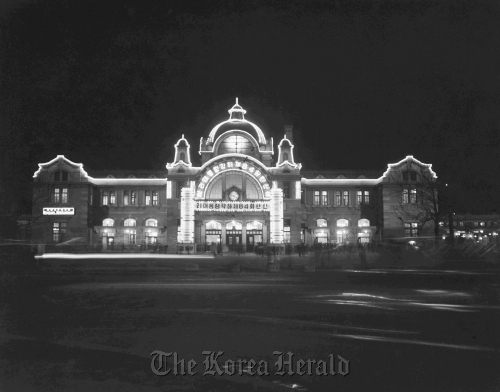Seoul has gone through a lot in the past century, from Japanese occupation to the Korean War, and rapid industrialization to prosperity.
Seoul Museum of History is holding two separate exhibitions featuring Korea’s capital in two different time periods that offer a rare glimpse into how the city has been transformed into what it is today.
One of the exhibitions, “Seoul 1953-1963” showcases photographs of Seoul in its post-war period in seven different categories: politics, social affairs, architecture, health & hygiene, transportation, city administration, and lives of ordinary citizens.
One photo in the category of politics shows Seoul Station decorated with neon signs, which were specially ordered by the government to celebrate President Rhee Syngman’s 84th birthday in 1959.
Another photograph shows the “Woonam” hall, which was named after the president’s pen name.
Photos of Jong-am apartment complex ― the very first set of apartment buildings in Korea ― are found in the architecture category.
 |
The neon signs of Seoul Station celebrate Korea’s first president Syngman Rhee’s 84th birthday in 1959. (Seoul Museum of History) |
In the post-war period, Seoul’s public hygiene was a huge issue, as most of public bathrooms, drainage, and garbage dump yards were unsanitary. The exhibition shows photos of people getting vaccination shots and notices for the removal of rats from households, which were part of the government’s measures to improve poor public hygiene and health.
Photos of Miss Korea pageant winners show the public’s preference for larger women at the time, a result of the poor diet and poverty that most Seoul citizens were experiencing at the time.
Meanwhile, the other exhibition, “Old Seoul through Foreign Eyes” showcases some of the most famous spots of Seoul in the 1930s.
Called “Gyeongseong” during the Japanese colonial period, Seoul in the 1930s was administered by the Japanese Governor-General of Korea. The exhibition, for the very first time, shows video footage of Gyeongseong shot by a Japanese officer of the Governor-General.
Aside from the video, more than 2,000 images of Gyeongseong will be displayed through kiosks. Virtual maps of both 1930s Gyeongseong and Seoul today will be available for the visitors to view and compare.
While “Seoul 1953-1963” runs until April 24, “Old Seoul through Foreign Eyes” closes on June 26.
For more information, call (02) 724-0274.
By Claire Lee (
clairelee@heraldcorp.com)








![[Today’s K-pop] Blackpink’s Jennie, Lisa invited to Coachella as solo acts](http://res.heraldm.com/phpwas/restmb_idxmake.php?idx=644&simg=/content/image/2024/11/21/20241121050099_0.jpg)